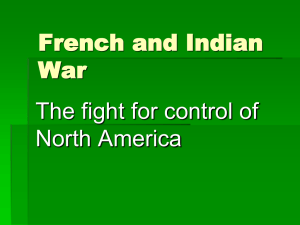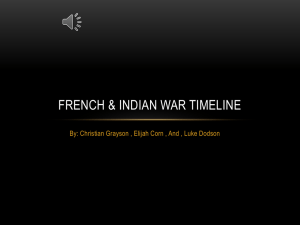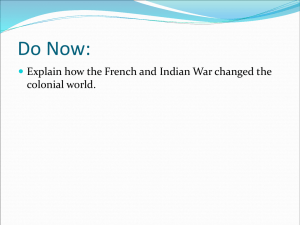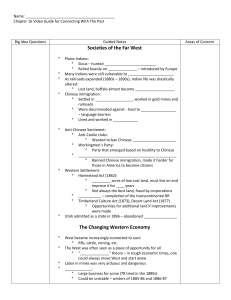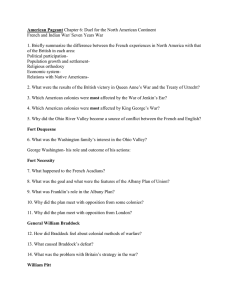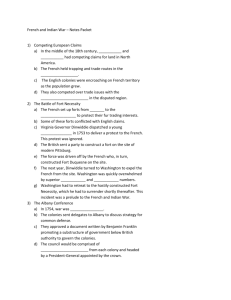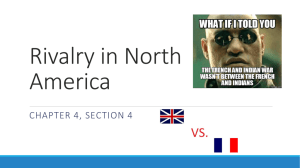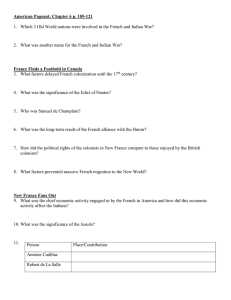The French and Indian War - West Morris Mendham High School
advertisement
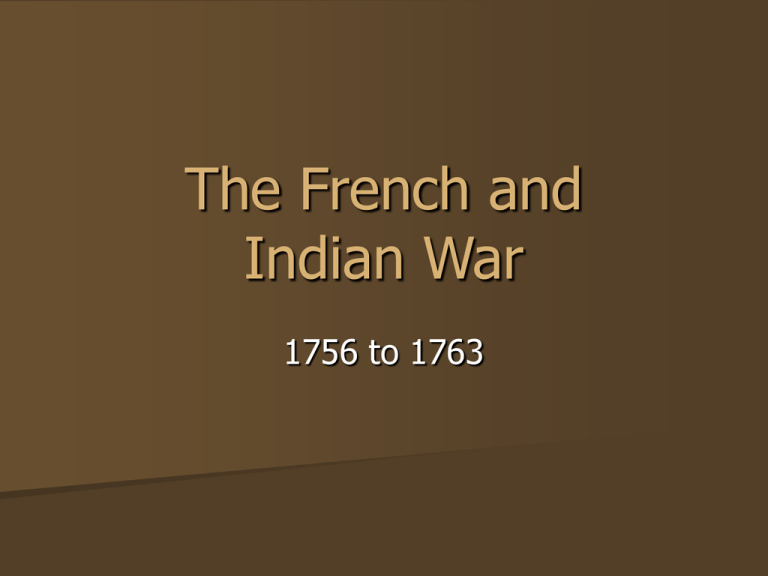
The French and Indian War 1756 to 1763 Beginning of the French & Indian War Objectives – How did the War Start – What were the causes? Local or Foreign problems? – What affect did this conflict have on GW? 3 Background Causes 1. Previous Conflicts between France and Britain 2. Colonies desire to Expand Westward 3. Natives desire to pit France against Britain, in hope they destroy each other and leave the frontier. 1. Previous Conflicts Britain and France had already had 3 indecisive wars in the previous ½ century. – King William’s War – Queen Anne’s War – King George’s War Conflicts in Europe that affected New World. 2. Desire to Expand - New France France claimed land – St. Lawrence River – Mississippi River Valley, named Louisiana New France population only grew to 80,000. No desire to build towns or raise families, there for the Fur Trade Befriended Natives for Trading Partners 2. Desire to Expand – British Colonies Only land is on the Eastern Seaboard British population had grown to over a million in the colonies wanted to expand westward. Start of the Conflict – 1754: Fighting Over the Same Land French built Fort Duquesne at start of the Ohio (now Pittsburgh) Virginia had given same land to a group of wealthy planters – Ohio Valley Company First Conflict Virginia militia was sent to order French to leave Led by George Washington (22), established Fort Necessity GW and men attacked small group of French soldiers, Natives with GW killed a French officer French countered attacking Fort Necessity British outnumbered, high losses, they were forced to surrender Second Conflict for Ohio Valley Region July 1755 - General Braddock, sent to recapture Fort Duquesne, with Washington as a volunteer assistant to the General "The Indians may be formidable to your raw American militia; upon the king's regulars and disciplined troops, it is impossible they should make any impression." ~ Braddock Washington warned that they may need to fight like the Indians, Braddock responded - "What! a provincial colonel teach a British general how to fight!" British were surrounded in the woods, exactly what Washington had warned. British outnumbered by French and Natives = Huge casualties – Braddock was killed, only 30 Virginians survived, British regulars fled. – Washington was lucky! "I luckily escaped without a wound, though I had four bullets through my coat, and two horses shot under me." British Lose to French and Indians During March to Duquesne Read the Article on GW Declaration of War Undeclared war continued for 1 and ½ years Finally declared war in May 1756. For the 1st 3 years of the war, French dominated the battlefield – Fort Ticonderoga – Fort Oswego – Fort William Henry British not used to the more “guerilla” warfare style. The Turning of the Tide King George II selected new leader to run government in 1757 Lord William Pitt borrowed $$$, “Spend Now, Pay later” Assembled largest, bestequipped army ever seen in N.A. with 50,000 men. Adapted war strategies to fit the territory and landscape of the American frontier. Became allies with important Natives, ie. Iroquis Ben Franklin Franklin saw the dangers on the American frontier after Braddock's 1755 defeat Got PA legislature funds to support the arming of a line of frontier forts to defend PA against the French/Indians, despite much legislative resistance “Join or Die” Colonists were divided on whether to fight the French Cartoon became a symbol for the need of organized action against an outside threat Franklin had proposed the Albany Plan in 1954 – A plan to place the colonies under a more centralized gov. – His cartoon suggested that such a union was necessary to avoid destruction – Although never carried out, it was the first important plan to conceive of the colonies as a collective whole united under one government. End of the War French were abandoned by many Indian allies. Exhausted,outnumbered and outgunned by the British French collapsed during the years 1758-59 British surprised and had a massive defeat of French at Quebec in September 1759. Treaty of Paris September 1760, the British controlled all of the North American frontier The war was effectively over. 1763 Treaty of Paris, which also ended the European “Seven Years War”, set the terms for France to abide by. – British gains Canada, east of Mississippi – Spanish given some land west of Mississippi – Natives given nothing North America 1763 Pontiac’s War Natives angered by: – trade relations with British – increase settlers past the Appalachian Mountains British continued to fight with the Indians over the issue of land claims. Captured English forts in Ohio Valley In return, British officers gave small pox infected blankets to natives, disease spread to others Natives weakened by disease and fighting, agreed to negotiate treaties by end of 1765. Chief Pontiac, led raids of British settlements The Proclamation of 1763 To prevent more fighting King George halted settler’s westward expansion Set Appalachian Mountains as the temporary boundary for the colonies Angered colonists who were: – already living in the area – recently purchased land there b/c claims now not recognized Created friction between the colonies and Great Britain Interesting Fact The French and Indian War was the Bloodiest American war in the 1700’s. More lives lost than the American Revolution
